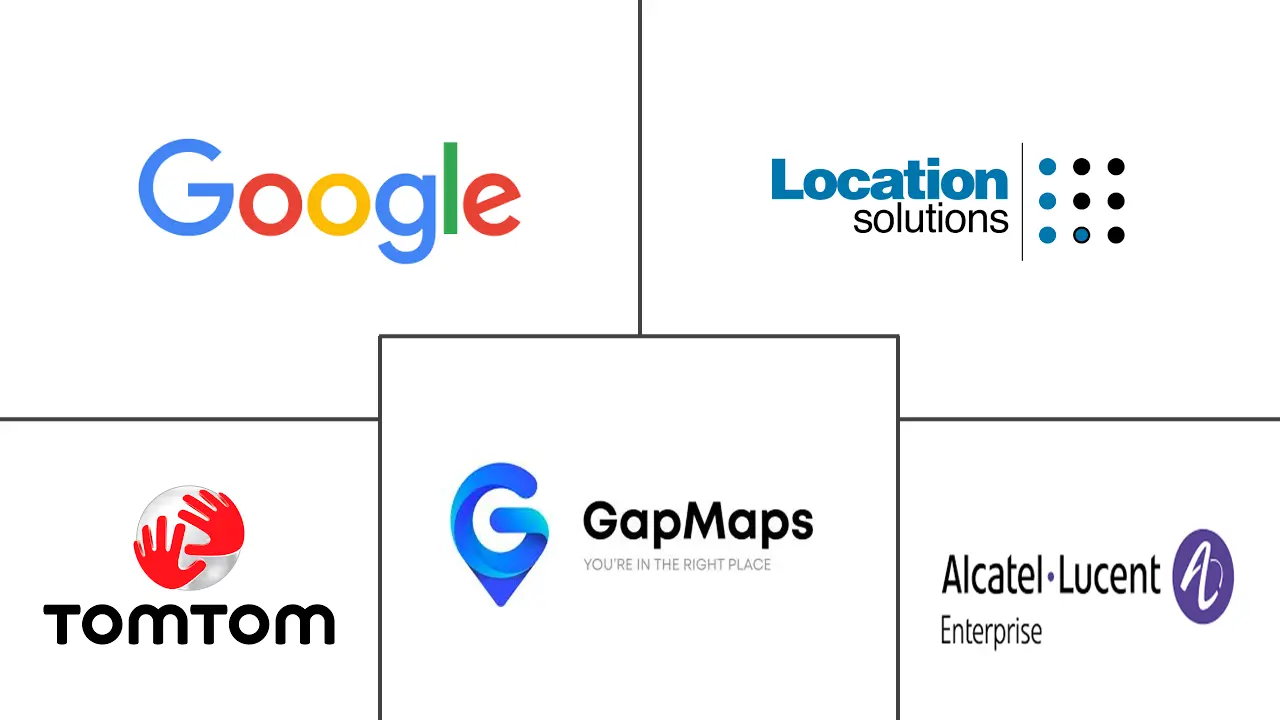UAE Location-based Services Market Size and Share
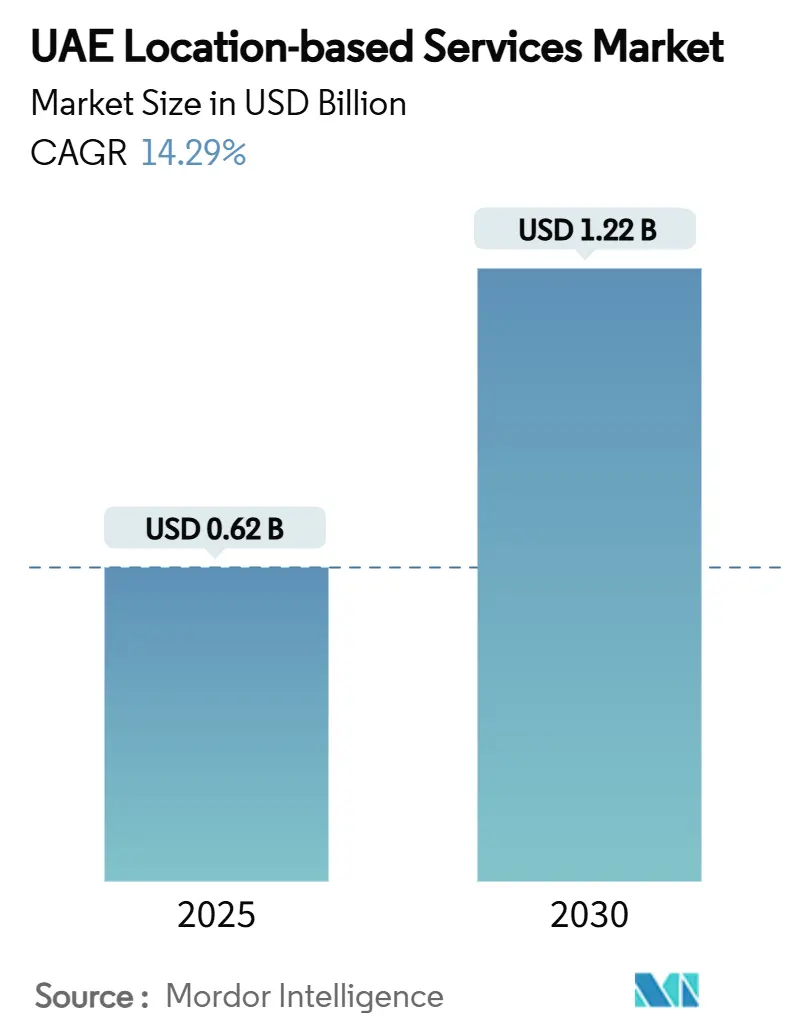
UAE Location-based Services Market Analysis by Mordor Intelligence
The UAE location-based services market size stands at USD 0.62 billion in 2025 and is projected to reach USD 1.22 billion by 2030, reflecting a 14.29% CAGR over the forecast period. Robust 5G coverage, ambitious smart-city programs, and rising enterprise demand for hyper-local analytics jointly accelerate adoption. Hardware still drives data collection, yet spending is shifting to AI-enabled software that turns raw coordinates into commercial insight. Indoor positioning enjoys tailwinds from retail, hospitality, and energy operators seeking worker safety and customer experience gains. E-commerce expansion pushes logistics firms to refine real-time routing, while telecom carriers open network APIs that let third-party developers monetize precise location data.
Key Report Takeaways
- By component, hardware captured 44.5% of the UAE location-based services market share in 2024; software is forecast to expand at a 27.83% CAGR through 2030.
- By location type, outdoor services held 62.1% revenue share of the UAE location-based services market size in 2024, whereas indoor positioning is advancing at a 28.76% CAGR through 2030.
- By application, mapping and navigation accounted for 23.9% of the UAE location-based services market size in 2024 and location-based advertising is growing at a 30.42% CAGR through 2030.
- By end-user vertical, transportation and logistics led with 27.4% share of the UAE location-based services market size in 2024, while IT and telecom is set to post the highest CAGR at 25.68% through 2030.
UAE Location-based Services Market Trends and Insights
Drivers Impact Analysis
| Driver | (~) % Impact on CAGR Forecast | Geographic Relevance | Impact Timeline |
|---|---|---|---|
| Nationwide 5G rollout enabling sub-meter indoor positioning | +3.2% | UAE-wide, concentrated in Dubai and Abu Dhabi | Medium term (2-4 years) |
| Government smart-city initiatives | +2.8% | Dubai and Abu Dhabi | Long term (≥ 4 years) |
| Rapid e-commerce growth driving hyper-local logistics | +2.1% | UAE-wide urban hubs | Short term (≤ 2 years) |
| High smartphone and social-media penetration | +1.8% | UAE-wide | Short term (≤ 2 years) |
| Mandatory e-call/telematics rules for commercial fleets | +1.5% | UAE-wide | Medium term (2-4 years) |
| UWB adoption for worker safety in energy facilities | +1.3% | Abu Dhabi and Northern Emirates | Medium term (2-4 years) |
| Source: Mordor Intelligence | |||
Nationwide 5G Rollout Enabling Sub-meter Indoor Positioning
Operators recorded live 5G speeds topping 30.5 Gbps, enabling centimeter-level accuracy inside malls, airports, and industrial plants. Release 18 standards add positioning features such as frequency hopping that reduce signal multipath error [1]Ericsson, “5G Advanced positioning in 3GPP Release 18,” ericsson.com . Early private 5G projects, including ADNOC’s 11,000 km² energy network, validate large-scale deployments that merge connectivity and geolocation in a single managed slice. Telecom carriers are exposing these capabilities through open APIs so software firms can embed assured location into consumer and enterprise apps. As coverage densifies across all seven emirates, service latency falls, unlocking AR navigation and autonomous trolley robots in retail stores.
Government Smart-City Initiatives (Smart Dubai, Abu Dhabi 2030)
Dubai earmarked AED 1.6 billion (USD 0.44 billion) for 82 digital projects that embed location analytics into public transport, utilities, and citizen services. The emirate targets 25% autonomous journeys by 2030, a milestone that relies on continuous positioning of vehicles and street assets. Abu Dhabi plans to run every departmental workflow on an AI stack by 2027, backed by AED 13 billion in digital infrastructure spending that prioritizes common geospatial platforms. Unified databases reduce duplication and create demand for high-quality mapping feeds. Super-apps such as TAMM already use location context to cut service-completion steps for residents. These programs produce sustained multi-year orders for mapping vendors and indoor analytics specialists.
Rapid E-commerce Growth Driving Hyper-local Logistics
Parcel volumes surge as cross-border marketplaces localize fulfillment centers inside the UAE. Logistics players such as Aramex automate route sequencing and real-time driver guidance to protect margins amid rising same-day delivery expectations. IoT tags on temperature-sensitive shipments allow shippers to intervene before spoilage. Niche providers supply Bluetooth-enabled pallets that report both coordinates and ambient data to control towers. The UAE ranked among the top ten economies for mobile-commerce spend per capita in 2024, intensifying competition to reach consumers within two-hour windows, a requirement impossible without high-resolution geocoding.
UWB Adoption for Worker Safety in Energy Facilities
Ultra-Wideband anchors achieve centimeter accuracy in metallic, obstructed settings where GPS and Wi-Fi falter. ADNOC expects private 5G plus UWB deployments to unlock USD 1.5 billion in value by reducing accidents and asset downtime. Wearables trigger automated shutdowns when staff enter exclusion zones. Over time, facility managers integrate UWB feeds with AI models that predict unsafe behaviors hours in advance, further boosting demand for unified location dashboards. Pilot successes in oilfields encourage chemical and cement producers to budget similar projects by 2026.
Restraint Impact Analysis
| Restraint | (~) % Impact on CAGR Forecast | Geographic Relevance | Impact Timeline |
|---|---|---|---|
| Heightened data-privacy compliance costs | -2.3% | UAE-wide | Short term (≤ 2 years) |
| GNSS signal fade in high-rise and indoor settings | -1.8% | Dubai and Abu Dhabi urban cores | Medium term (2-4 years) |
| High indoor-5G capital costs for malls and hotels | -1.4% | Major tourist districts | Medium term (2-4 years) |
| Fragmented emirate-level open-data APIs | -0.9% | Inter-emirate operations | Long term (≥ 4 years) |
| Source: Mordor Intelligence | |||
Heightened Data-privacy Compliance Costs
The Personal Data Protection Law mirrors GDPR rules and fines violators up to AED 5 million (USD 1.36 Million)[3]Secure Privacy, “Guide to UAE Data Protection Law (PDPL),” secureprivacy.ai. Location providers now appoint data-protection officers, update consent flows, and encrypt historical logs, adding overhead that can reach 8-10% of project budgets. Global vendors face dual audits when processing UAE records in foreign data centers. Compliance has already delayed rollouts of ad-tech platforms that rely on continuous location tracking, prompting some retailers to adopt on-device analytics to minimize data transfers. Government pilots of biometric IDs show regulators will favor privacy-by-design architectures.
GNSS Signal Fade in High-rise and Indoor Settings
Urban canyons in Dubai’s central business district create multipath distortion, degrading GPS accuracy to tens of meters. Studies on Wi-Fi fingerprinting reveal high scan latency and client density issues that further impair indoor resolution. Providers must combine Bluetooth, cellular, and inertial sensors, raising integration complexity and lead time. Solutions such as resonant radio mapping improve baseline performance but still require site surveys every time floor layouts change. Consequently, some mall operators postpone full-scale deployments until chipset support for sensor fusion matures.
Segment Analysis
By Component: Software Accelerates Value Creation
Hardware retained 44.5% revenue in 2024, yet software is set to grow at 27.83% CAGR, far outpacing physical devices. The UAE location-based services market size for software is projected to surpass hardware by 2028 as enterprises favor cloud dashboards that transform coordinates into predictive insights. Price erosion in chipsets pressures margins, pushing vendors toward subscription analytics engines. Microsoft’s AED 2 billion (USD 0.54 Billion) hyperscale data center with du illustrates rising investment in AI accelerators that preprocess location streams.
Service contracts expand as integrators calibrate indoor beacons, align mapping layers with privacy policies, and train users on dashboards. Complex multicloud scenarios, where data flows between Azure and on-premise clusters inside oil refineries, sustain recurring revenue for consultancy arms. Patent filings by Meta and Apple underline a shift to context-aware algorithms that adjust accuracy based on motion state, pointing to continued software innovation.
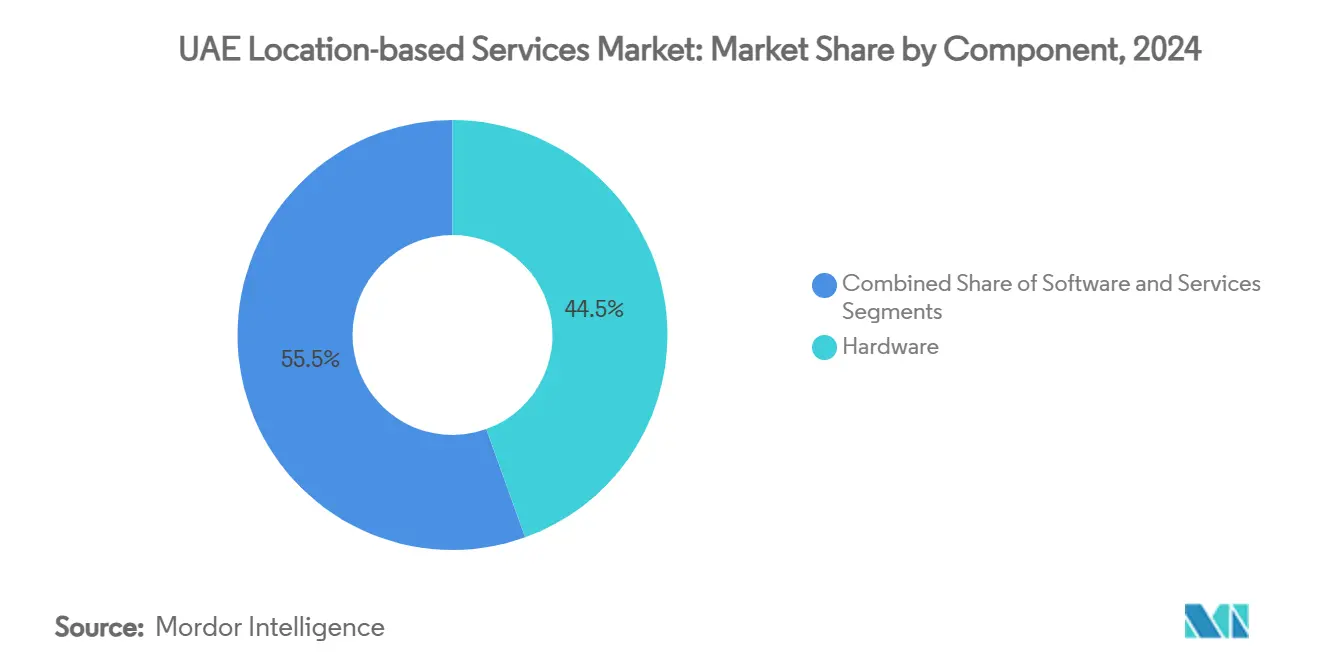
Note: Segment shares of all individual segments available upon report purchase
By Location Type: Indoor Positioning Gains Momentum
Outdoor solutions commanded 62.1% of 2024 spending, driven by fleet telematics and consumer navigation apps. Yet indoor deployments are climbing 28.76% annually, adding hospitals, malls, airports, and refineries to the addressable base. The UAE location-based services market share for indoor systems is expected to exceed 40% by 2030 as beacon prices fall and Wi-Fi 6E spreads. Reem Mall’s full-coverage rollout shows visitors engage longer when wayfinding and loyalty vouchers combine in a single app.
Accuracy advances near 20 centimeters using UWB tags, proven in road-worker safety pilots that achieved 97% correct zone classification [2]MDPI, “Untethered Ultra-Wideband Real-Time Locating System,” mdpi.com . Hotels adopt indoor grids to trigger housekeeping alerts when guests leave rooms, reducing wait times. Energy majors embed tags in personal protective equipment to geo-fence hazard zones, meeting compliance with minimal manual checks.
By Application: Advertising Outpaces Traditional Navigation
Mapping and navigation kept 23.9% of 2024 turnover, but advertisers are investing faster as geofencing returns clear sales lifts. Location-based advertising is growing 30.42% per year and will rival navigation revenue by 2029. The UAE location-based services market size for advertising links directly to high smartphone penetration and affluent shopper profiles. Palm ID biometric payments enable instant, location-triggered checkout, letting brands close the loop from notification to purchase.
Business-intelligence dashboards analyze foot-traffic patterns so retailers tailor inventory to micro-catchments. Social apps add ephemeral location pins to foster meet-ups, supporting ad inventory. Healthcare pilots use location to timestamp vitals for chronic patients, illuminating a long-tail of “other” use cases that will collectively approach double-digit share by 2030.
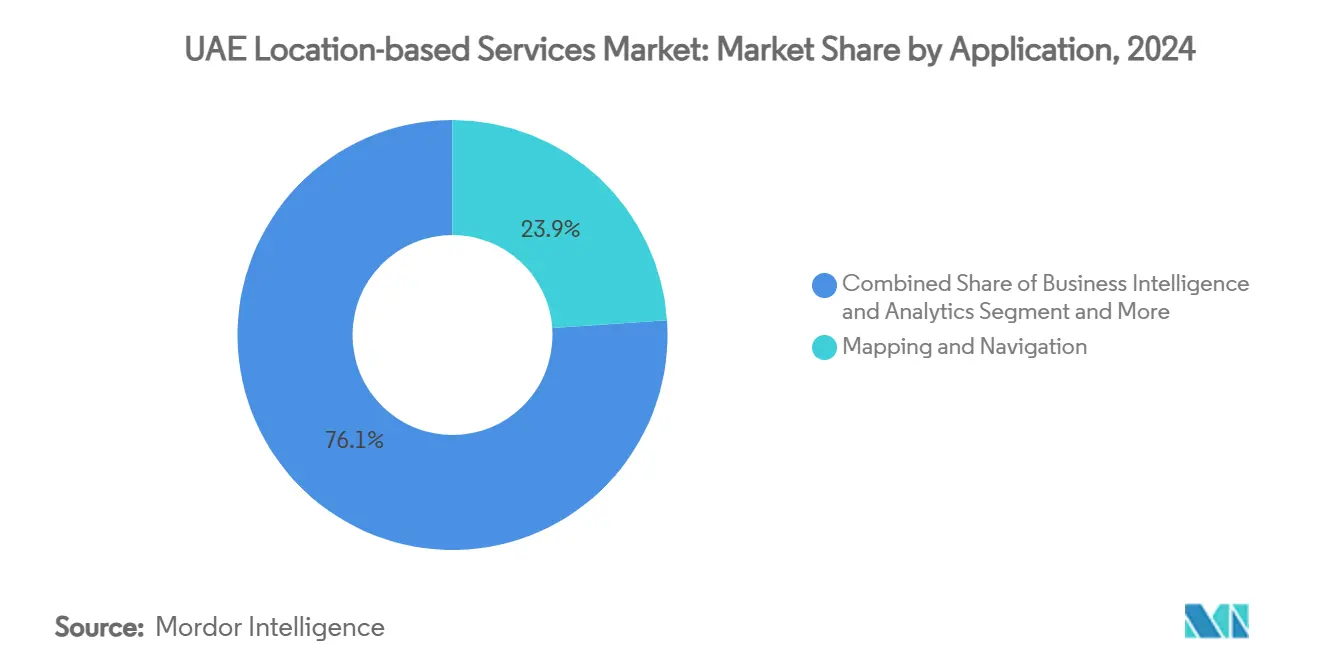
Note: Segment shares of all individual segments available upon report purchase
By End-user Vertical: Telecom Leads, Logistics Remains Vital
Transportation and logistics owned 27.4% of 2024 revenue, reflecting early telematics adoption. Yet IT and telecom grows quickest at 25.68% CAGR as carriers seek new revenue beyond data bundles. Operators like eand bundle network slices with indoor analytics, positioning themselves as one-stop platforms for enterprises. The UAE location-based services industry now views location as a service layer rather than a discrete product.
Healthcare networks encrypt patient coordinates across 160 sites under Fortinet security, validating location’s role in sensitive workflows. Government agencies knit together police, fire, and civil services through shared GIS layers that slash response times. Banks push location-aware fraud alerts to reduce card misuse, and hoteliers deploy guest-wayfinding to differentiate premium properties.
Geography Analysis
Dubai and Abu Dhabi dominated roughly 75% of 2024 spending thanks to dense populations, tourist flows, and public-sector digital budgets. The UAE location-based services market size in Dubai benefits from autonomous-vehicle pilots that require always-on mapping feeds. Abu Dhabi’s AI-native government plan draws hyperscale datacenters that demand granular geospatial data for model training.
Sharjah, Ajman, and Ras Al Khaimah show double-digit growth as real-estate and tourism investments rise. Sharjah’s IoT firms export cold-chain trackers across the Gulf, highlighting regional spillovers. Ras Al Khaimah’s upcoming Hilton resort intends to merge indoor navigation with loyalty dashboards on opening day.
Fujairah and Umm Al Quwain contribute modest shares but adopt maritime and port logistics solutions that demand precise location to schedule bunkering and cargo transfers. Federal programs aim to unify emirate APIs by 2025, lowering integration friction for cross-border fleets.
Competitive Landscape
Global map majors HERE, TomTom, and Apple supply SDKs to mobility platforms, while Microsoft courts government accounts through Azure Maps. Telecom incumbents eand and du convert 5G infrastructure into enterprise location clouds, capturing data-sovereignty-sensitive deals. The UAE location-based services market sees mid-tier specialists provide indoor kits and sector-specific dashboards, enabling hospitals and refineries to adopt without building from scratch.
Strategic alliances dominate: eand pairs with IBM on AI governance so clients can audit location flows. Qualcomm teams with eand to bundle edge AI and industrial 5G, accelerating factory uptake. Uber selects HERE for global map refresh and collaborates with WeRide to run robotaxis in both Abu Dhabi and Dubai.
Patent races intensify around UWB discovery and sensor fusion, raising barriers for new entrants. Market consolidation looms as software house valuations hinge on recurring subscription ratios. The top five vendors held just under 60% combined revenue in 2024, indicating a moderately concentrated field open to niche challengers.
UAE Location-based Services Industry Leaders
-
Google LLC
-
Location Solutions Telemetics LLC.
-
TomTom International BV
-
GapMaps
-
ALE International
- *Disclaimer: Major Players sorted in no particular order
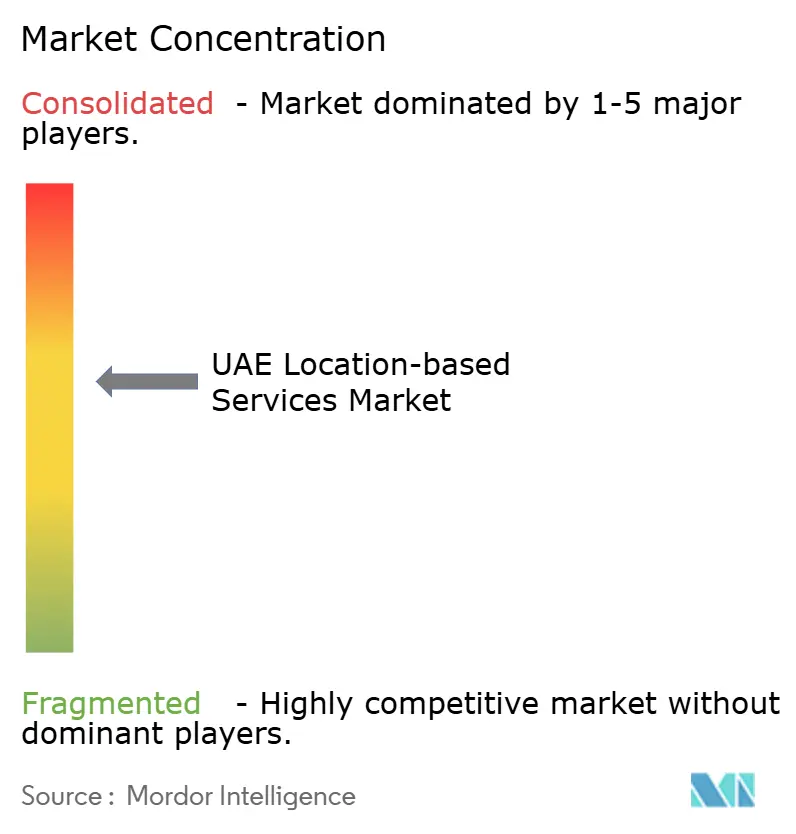
Recent Industry Developments
- July 2025: Uber and Baidu announced a multiyear partnership to deploy thousands of autonomous vehicles on the Uber platform across the Middle East, with the UAE serving as a key launch market for robotaxi services.
- June 2025: The Stargate UAE AI datacenter project received approval to begin operations in 2026, with the first phase featuring 1-gigawatt capacity and 100,000 Nvidia chips.
- May 2025: e&UAE launched 5G network slicing for businesses in partnership with Nokia, enabling customized network applications that enhance location-based services.
- May 2025: Qualcomm and e& announced a collaboration to advance 5G and edge AI technologies in the UAE.
UAE Location-based Services Market Report Scope
Location-based services (LBSs) are computer or mobile applications that provide information based on the device's location and the user, primarily through mobile portable devices, such as smartphones and mobile networks. The precision of the location services primarily depends on the hardware and software used in the mobile communication system, along with the positioning server.
The UAE location-based services market is segmented by component (hardware, software, services), location (indoor and outdoor), application (mapping and navigation, business intelligence and analytics, location-based advertising, social networking, entertainment, and other applications), and end-user (transportation and logistics, IT and telecom, healthcare, government, BFSI, hospitality, manufacturing, and other end-user).
The market sizes and forecasts are provided in terms of value (USD) for all the above segments.
| Hardware |
| Software |
| Services |
| Indoor |
| Outdoor |
| Mapping and Navigation |
| Business Intelligence and Analytics |
| Location-based Advertising |
| Social Networking and Entertainment |
| Other Applications |
| Transportation and Logistics |
| IT and Telecom |
| Healthcare |
| Government |
| BFSI |
| Hospitality |
| Manufacturing |
| Other End-users |
| By Component | Hardware |
| Software | |
| Services | |
| By Location Type | Indoor |
| Outdoor | |
| By Application | Mapping and Navigation |
| Business Intelligence and Analytics | |
| Location-based Advertising | |
| Social Networking and Entertainment | |
| Other Applications | |
| By End-user Vertical | Transportation and Logistics |
| IT and Telecom | |
| Healthcare | |
| Government | |
| BFSI | |
| Hospitality | |
| Manufacturing | |
| Other End-users |
Key Questions Answered in the Report
What is the current value of the UAE location-based services market?
The market is valued at USD 0.62 billion in 2025 and is forecast to reach USD 1.22 billion by 2030.
Which segment grows fastest in the UAE location-based services market?
Indoor positioning systems exhibit the fastest CAGR at 28.76% thanks to retail, hospitality, and energy deployments.
Why are telecom operators investing heavily in location services?
Carriers such as eand and du monetize 5G network slices and AI platforms, generating new revenue beyond voice and data by offering location analytics to enterprises.
How do privacy regulations affect market growth?
The Personal Data Protection Law increases compliance costs and drives firms to adopt privacy-by-design architectures, trimming the overall CAGR by an estimated 2.3%.
Page last updated on:
